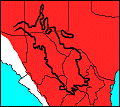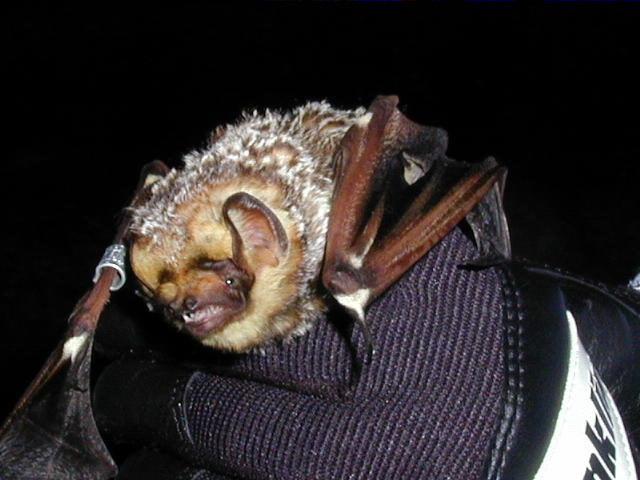


Hoary Bat (Lasiurus cinereus). Photograph courtesy of US Forest Service, USDA.
This bat is migratory and moves northward in spring and southward in winter (Findley and Jones 1964). Like the red bats, relatives and sometime associates, the Hoary Bat is usually a solitary animal but also may live in a mother and young family group (Tuttle 2003). The Hoary Bat prefers wooded areas where it roosts in the open by hanging from a branch or twig (Alden et al. 1999). It is a strong flier, and when with other bats, it is easily recognized by its large size and swift, erratic flight (Davis and Schmidly 1994). Another characteristic of this bat that makes it easily recognized is its propensity for audible chattering during flight (Schmidly 1977). This bat usually emerges rather late in the evening, but during migration it frequently is observed in daylight hours (Davis and Schmidly 1994).
Alden, P., B. Cassie, P. Friederici, J. D. W. Kahl, P. Leary, A. Leventer, and W. B. Zomlefer. 1999. National Audubon Society field guide to the southwestern states. Alfred A. Knopf, New York.
Davis, W. B., and D. J. Schmidly. 1994. The mammals of Texas. Texas Parks and Wildlife Press, Austin.
Findley, J. S., and C. Jones. 1964. Seasonal distribution of the hoary bat. Journal of Mammalogy, 45:461-470.
Schmidly, D. J. 1977. The mammals of Trans-Pecos Texas including Big Bend National Park and Guadalupe Mountains National Park. Texas A&M University Press, College Station.
Tuttle, M. D. 2003. Texas bats. Bat Conservation International, Inc., Austin.
GeoIMAGERY Association. Photograph.
University of Michigan Museum of Zoology: Animal Diversity Web. Photograph, natural history, and references.
A. Ruth Huckaby, Graduate Student, BIOL 5301-Natural History of the Chihuahuan Desert, June, 2006.
Huckaby Update: 22 Jun 2006
Last Update: 23 Jul 2009